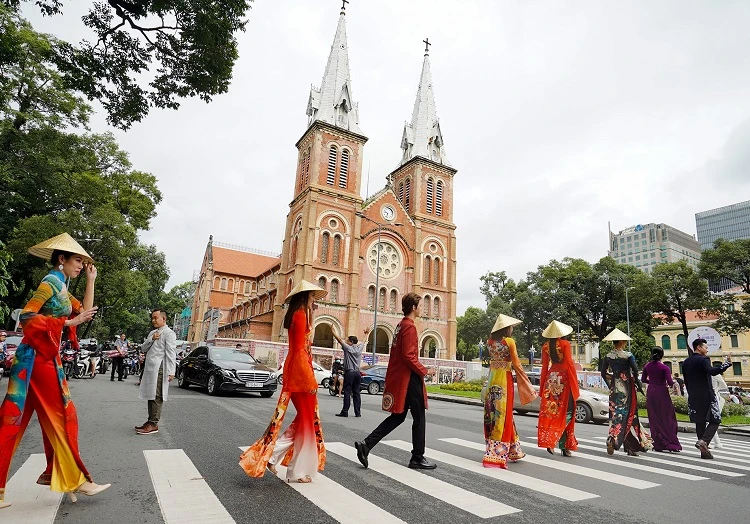
Let's Talk Numbers
Ho Chi Minh City has long been considered a prominent source market for both domestic and international tourism. However, recent years have witnessed remarkable transformations in the city's tourism sector, driven by a renewed sense of purpose. Statistical data from peak holiday and summer seasons tell the story.
During the 4-day holiday surrounding September 2, it's estimated that the number of visitors to the city's tourist and entertainment hubs reached a staggering 960,000, representing a 4.3% increase compared to the same period in 2022. Notably, room occupancy rates reached an estimated 80%, marking a 6.7% increase over the previous year. In terms of revenue, it reached approximately VND 2,890 billion, reflecting a 5.5% year-on-year increase. In the first six months of the year, Ho Chi Minh City's tourism revenue reached an estimated VND 80,833 billion, a remarkable 62.7% increase compared to the same period in the previous year, making it the top destination for tourism revenue in the country.
One noteworthy initiative is the "Each District, a Unique Tourism Product" program, which is increasingly leveraging district-level resources to harness tourism potential. According to Mr. Lê Trương Hiền Hòa, Deputy Director of the Ho Chi Minh City Department of Tourism, this program has resulted in the creation of 60 new product tours.
Looking ahead, the Department of Tourism recommends that district People's Committees and Thu Duc City continue to promote local strengths, including distinctive offerings like shoemaking and diverse culinary tourism. They should also foster collaboration with neighboring areas to invigorate tourism development, enhance the city's appeal, and create a ripple effect to boost tourism activities.
Furthermore, in 2023, the city's tourism industry will introduce new products and programs, such as tours of national architectural and artistic relics, river festivals, and bread festivals. Assessing the transformation of Ho Chi Minh City's tourism sector, Mr. Phan Đình Huê, Director of Vietcircle Tourism Company, views these developments as highly positive.
According to Mr. Huê, since the onset of the pandemic, when international visitor numbers have remained subdued, the city's tourism industry has rapidly rolled out a range of products and events aimed at enticing domestic tourists. Notably, recognizing the current trend favoring nearby and domestic destinations, the city initiated the "City People Go on City Tours" program, yielding promising results for Ho Chi Minh City's tourism sector.
The Need for a Breakthrough
While Ho Chi Minh City has successfully attracted domestic tourists, it's equally vital to revive international tourism. Statistics show that in the first nine months of the year, international visitor numbers reached 3.6 million, a 69% increase compared to the same period in the previous year. Among the initiatives aimed at rekindling international interest in the city, the 17th Ho Chi Minh City International Tourism Fair in 2023 has proven pivotal. The event attracted nearly 200 international buyers from 42 countries and territories, eager to explore new and unique tourism products and programs branded with the Ho Chi Minh City label.
Beyond sightseeing, there's a need for products that encourage tourists to spend more. Despite being a major economic and cultural hub, Ho Chi Minh City currently lacks entertainment and shopping options, particularly night tourism offerings. When discussing the development of night tourism products, Mr. Đặng Mạnh Phước, CEO of The Outbox Company, noted that local authorities' interest in night tourism is a positive sign. However, it's essential to acknowledge that many localities offer similar night tourism models, such as pedestrian streets, food streets, night markets, and cultural and entertainment activities, but these typically do not extend late into the night, let alone into the early morning.
To attract international visitors, it's essential to focus on MICE (Meetings, Incentives, Conferences, and Events) tourism products, which have the potential to yield significant revenue. According to Mr. Phan Đình Huê, promoting the attraction of MICE tourists hinges on resolving two key challenges: infrastructure and bureaucracy. MICE tourists typically comprise large groups, ranging from several hundred to several thousand individuals. While Ho Chi Minh City boasts numerous 4- and 5-star hotels, venues capable of hosting thousands of guests are scarce. Mr. Huê questioned why the city, a major economic center in the southern region, has not yet addressed this infrastructure gap when other localities, such as Da Nang, have succeeded in doing so. Recently, an Australian magazine specializing in event business highlighted Da Nang as a "hot" MICE tourism destination.
Challenges in terms of procedures and permits pose hurdles for many travel companies operating in MICE tourism. Given that MICE tourists often participate in a wide range of activities during their trips, handling procedures and obtaining permits can be time-consuming. To address these challenges and bolster the development of MICE tourism, Ho Chi Minh City is prioritizing the enhancement of product and service quality, as well as accommodation facilities.
Furthermore, like many other regions across the country, Ho Chi Minh City's tourism industry is anticipating the positive impact of a new visa policy, effective since August 15. This policy is expected to exert a substantial influence during the upcoming international tourist season.
In summary, Ho Chi Minh City's tourism sector has made significant strides in attracting domestic tourists, but it remains poised for further growth. The city recognizes the need to rekindle international tourism and is actively working to address infrastructure and bureaucratic challenges. Additionally, the development of MICE tourism and night-time entertainment offerings could further enhance the city's appeal to a global audience. With its unwavering commitment to innovation and improvement, Ho Chi Minh City continues to evolve as a premier tourism destination in Vietnam.




















